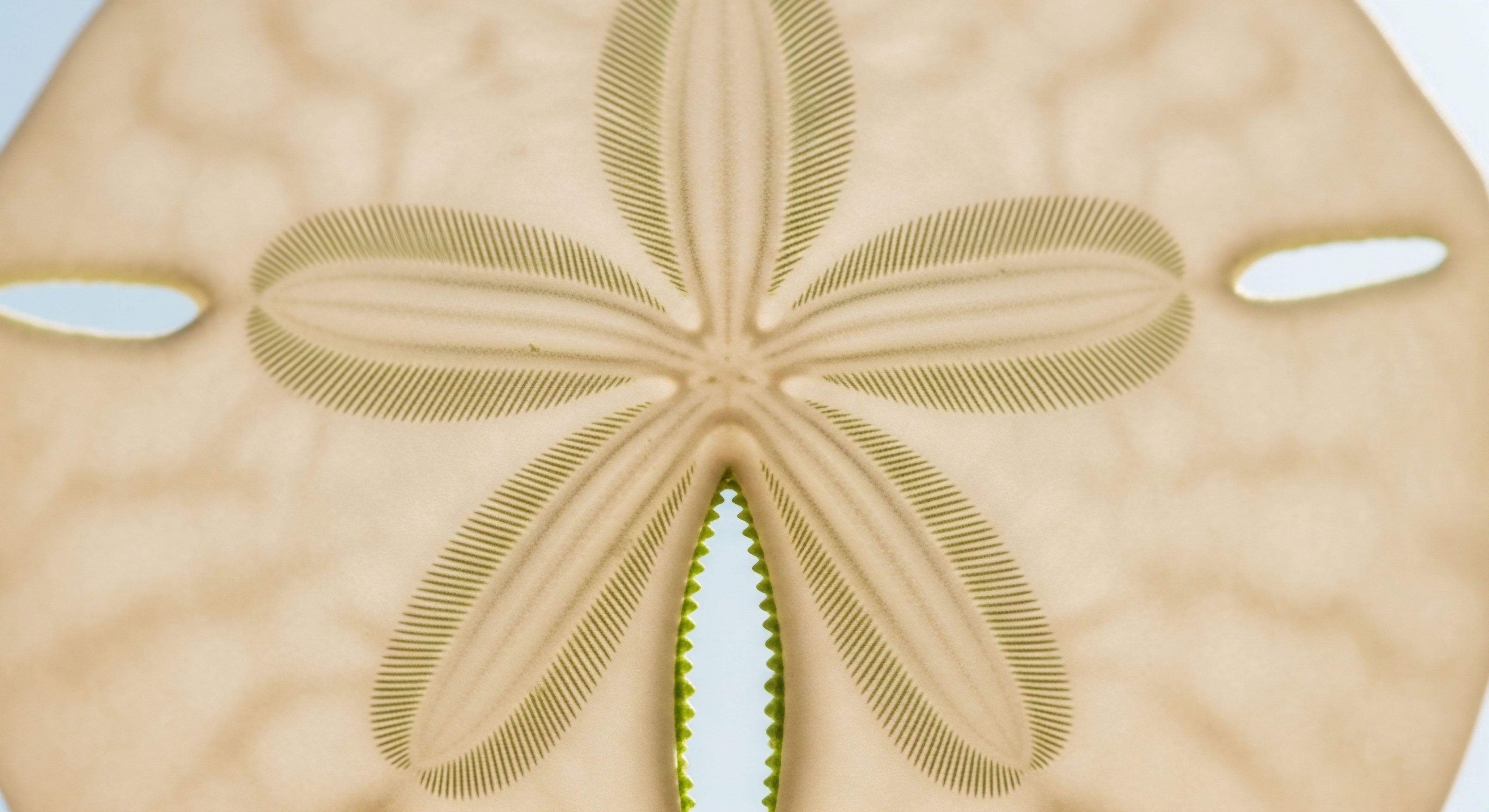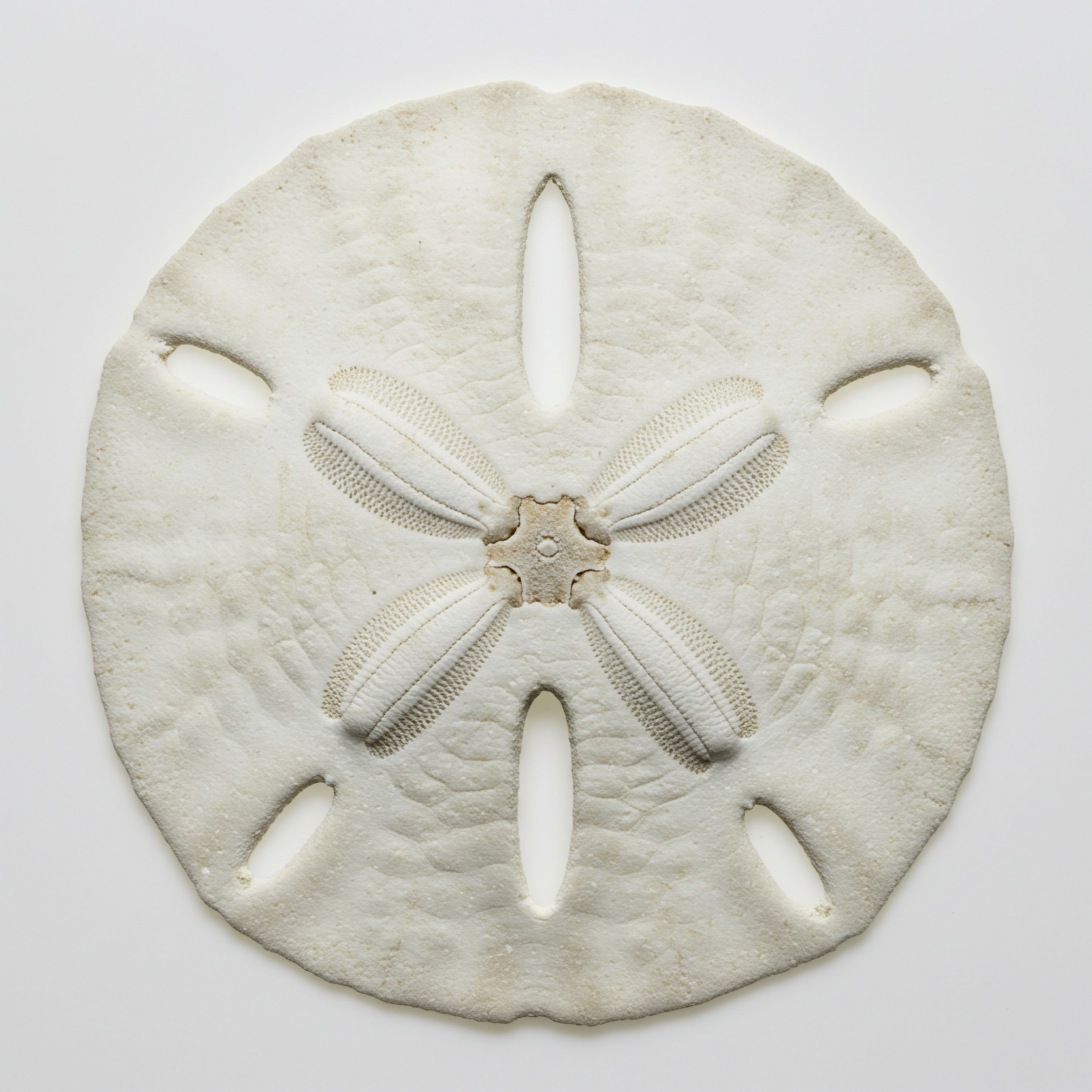

Fundamentals
You may have noticed changes in your skin over time ∞ a loss of firmness, the appearance of fine lines, or a general lack of vibrancy. It is a common experience to attribute these shifts solely to age or external factors.
The reality is that your skin’s health is deeply connected to the complex and dynamic world of your internal biochemistry. The resilience and vitality of your skin are not merely surface-level concerns; they are direct reflections of your underlying hormonal and metabolic state. Understanding this connection is the first step toward reclaiming your skin’s inherent strength and function.
Hormones are the body’s primary signaling molecules, orchestrating a vast array of physiological processes, from energy utilization to cellular repair. When these signals are balanced and robust, every system in your body, including your largest organ ∞ the skin ∞ functions optimally.
When these hormonal communications become disrupted or decline, as they naturally do with age, the skin is one of the first places these changes become visible. This is because key hormones like estrogen, testosterone, and growth hormone Meaning ∞ Growth hormone, or somatotropin, is a peptide hormone synthesized by the anterior pituitary gland, essential for stimulating cellular reproduction, regeneration, and somatic growth. directly influence the cells responsible for producing collagen and elastin, the foundational proteins that give skin its structure and elasticity.
The concept of hormonal optimization Meaning ∞ Hormonal Optimization is a clinical strategy for achieving physiological balance and optimal function within an individual’s endocrine system, extending beyond mere reference range normalcy. is about restoring these critical signaling pathways to a state of youthful efficiency. It involves a precise and personalized approach to identify and correct imbalances, thereby supporting the body’s innate capacity for repair and regeneration.
By addressing the root biochemical drivers of skin aging, these protocols provide the necessary support for your skin to rebuild its structural integrity from within. This internal recalibration allows the skin to better withstand environmental stressors, retain moisture, and maintain a smoother, more resilient appearance. It is a physiological strategy that views the skin not as a passive barrier to be topically treated, but as an active, dynamic organ that can be revitalized through systemic health.


Intermediate
To appreciate how hormonal optimization protocols Meaning ∞ Hormonal Optimization Protocols are systematic clinical strategies designed to restore or maintain optimal endocrine balance. directly enhance skin resilience, we must look at the specific roles key hormones play at a cellular level. The skin’s dermal layer is populated with specialized cells called fibroblasts, which are responsible for synthesizing collagen, elastin, and hyaluronic acid ∞ the triad of molecules that dictates skin firmness, elasticity, and hydration. The function of these fibroblasts is heavily modulated by hormonal signals.
Hormonal optimization works by directly stimulating the cellular machinery responsible for skin structure and repair.

The Influence of Sex Hormones on Dermal Health
Estrogen, progesterone, and testosterone each have distinct and vital functions in maintaining skin integrity. A decline in these hormones, characteristic of perimenopause, menopause, and andropause, directly correlates with accelerated skin aging.
Estrogen is a primary driver of collagen production and skin hydration. It binds to estrogen receptors (ERα and ERβ) found on dermal fibroblasts, signaling these cells to increase the synthesis of Type I and Type III collagen. This process thickens the dermis, improves its structural integrity, and reduces the appearance of fine lines. Estrogen also enhances the production of hyaluronic acid, a molecule that can hold up to 1,000 times its weight in water, thereby maintaining skin plumpness and moisture.
Progesterone complements estrogen’s effects, contributing to skin elasticity and hydration. While its mechanisms are less direct, progesterone appears to influence sebum production, which helps maintain the skin’s protective lipid barrier. A healthy barrier prevents transepidermal water loss, keeping the skin hydrated and resilient against environmental irritants.
Testosterone, often overlooked in female skin health, is crucial for maintaining dermal thickness and firmness. Like estrogen, testosterone stimulates collagen synthesis, contributing to the skin’s structural support system. In men, the age-related decline in testosterone is a significant factor in skin thinning and loss of elasticity.
In women, a balanced level of testosterone is essential for maintaining this structural foundation. Testosterone Replacement Therapy Meaning ∞ Testosterone Replacement Therapy (TRT) is a medical treatment for individuals with clinical hypogonadism. (TRT), when properly administered, has been shown to increase skin thickness and improve its ability to develop and maintain muscle, which indirectly supports facial structure.

How Do Growth Hormone Peptides Contribute to Skin Vitality?
Growth hormone (GH) is another powerful signaling molecule with profound effects on tissue regeneration, including the skin. As natural GH production declines with age, the body’s ability to repair cellular damage diminishes. Growth hormone peptide therapy utilizes secretagogues like Ipamorelin, Sermorelin, and CJC-1295 to stimulate the pituitary gland’s own production of GH. This approach is a bio-regulatory one, restoring a more youthful pattern of GH release.
The benefits for the skin are significant:
- Increased Collagen Synthesis ∞ Elevated GH levels signal the liver to produce Insulin-Like Growth Factor 1 (IGF-1), a primary mediator of GH’s effects. IGF-1, along with GH itself, stimulates fibroblast activity, leading to enhanced collagen and elastin production.
- Improved Skin Firmness and Moisture ∞ Clinical observations note that therapies which increase growth hormone levels can improve skin firmness and moisture retention. This is likely due to the combined effect of increased dermal proteins and improved cellular hydration.
- Accelerated Healing ∞ GH plays a critical role in all phases of wound healing and tissue repair. By enhancing cellular turnover and regeneration, these peptides help the skin recover more quickly from injury and daily environmental damage.
The following table outlines the primary hormones used in optimization protocols and their specific contributions to skin resilience.
| Hormone/Peptide | Primary Mechanism of Action | Observed Effect on Skin |
|---|---|---|
| Estrogen | Binds to ERα/ERβ on fibroblasts, stimulating collagen and hyaluronic acid synthesis. | Increases skin thickness, hydration, and elasticity; reduces wrinkles. |
| Testosterone | Binds to androgen receptors, stimulating collagen production. | Improves skin thickness, firmness, and elasticity. |
| Progesterone | Modulates sebum production and supports the skin’s lipid barrier. | Enhances skin hydration and improves texture. |
| Growth Hormone Peptides (e.g. Ipamorelin) | Stimulate endogenous GH and IGF-1 production, promoting cellular repair. | Increases collagen synthesis, improves skin firmness, and accelerates healing. |
By addressing deficiencies in these key signaling molecules, hormonal optimization protocols provide a systemic solution to skin aging. This approach moves beyond topical treatments to fundamentally rebuild the skin’s structural and functional resilience from the inside out.


Academic
A sophisticated analysis of hormonal optimization reveals its efficacy in promoting skin resilience Meaning ∞ The skin’s inherent capacity to withstand mechanical, chemical, and environmental stressors, maintaining its structural integrity and functional efficacy, followed by efficient recovery to its baseline physiological state. through the intricate regulation of cellular signaling pathways and gene expression within dermal fibroblasts. The age-related decline in steroid hormones and growth factors precipitates a cascade of molecular events that degrade the extracellular matrix Meaning ∞ The Extracellular Matrix, often abbreviated as ECM, represents the non-cellular component present within all tissues and organs, providing essential physical scaffolding for cellular constituents and initiating crucial biochemical and biomechanical signals. (ECM), the very scaffold that provides skin with its mechanical strength and elasticity. Hormonal optimization protocols function by intervening directly in these pathways, recalibrating the cellular machinery toward an anabolic, regenerative state.

The Genomic and Non-Genomic Actions of Estrogen on Fibroblasts
The influence of 17β-estradiol (E2) on skin is mediated through both classical genomic and rapid non-genomic signaling. In the genomic pathway, E2 binds to nuclear estrogen receptors (ERα and ERβ), which then act as ligand-activated transcription factors.
These receptors form homodimers or heterodimers and bind to estrogen response elements (EREs) in the promoter regions of target genes, upregulating the transcription of genes coding for Type I and Type III procollagen, as well as fibrillin. This directly increases the synthesis of the skin’s primary structural components.
Hormonal therapies fundamentally alter gene expression in skin cells, shifting them from a catabolic to an anabolic state.
Concurrently, E2 exerts non-genomic effects through membrane-associated estrogen receptors (mERs) and the G protein-coupled estrogen receptor (GPER/GPR30). Activation of GPER, for instance, triggers a rapid, transient phosphorylation of the ERK1/2 signaling cascade, independent of new protein synthesis.
This pathway is critical for modulating fibroblast cytoskeletal organization, cell shape, and motility ∞ all essential for maintaining dermal integrity and facilitating wound repair. The loss of estrogen leads to a disorganized cytoskeleton and a reduction in focal adhesions, which is reversed by E2 administration through this non-classical pathway.

Testosterone’s Role in Modulating Dermal Matrix Homeostasis
Testosterone’s impact on skin resilience is mediated by its conversion to dihydrotestosterone (DHT) and its direct action on androgen receptors Meaning ∞ Androgen Receptors are intracellular proteins that bind specifically to androgens like testosterone and dihydrotestosterone, acting as ligand-activated transcription factors. (AR) expressed in dermal fibroblasts and keratinocytes. The binding of androgens to ARs modulates the expression of genes involved in ECM homeostasis.
Specifically, testosterone has been demonstrated to increase the expression of genes for procollagen and to inhibit the activity of matrix metalloproteinases (MMPs), enzymes responsible for collagen degradation. This dual action ∞ promoting synthesis while inhibiting breakdown ∞ creates a net anabolic effect on the dermal matrix, leading to increased skin thickness Meaning ∞ Skin thickness represents the collective measurement of the epidermis and dermis, comprising the vertical dimension of the integumentary system. and tensile strength.
The following table provides a comparative overview of the signaling pathways activated by key hormones in dermal fibroblasts.
| Hormone | Receptor Type | Key Signaling Pathway | Primary Transcriptional Target | Net Cellular Outcome |
|---|---|---|---|---|
| Estrogen (Genomic) | Nuclear (ERα, ERβ) | Ligand-activated transcription factor binding to EREs | COL1A1, COL3A1, FBN1 | Increased ECM protein synthesis |
| Estrogen (Non-Genomic) | Membrane (GPER/GPR30) | G-protein coupled activation of ERK1/2 pathway | N/A (protein phosphorylation) | Cytoskeletal reorganization, enhanced cell motility |
| Testosterone | Nuclear (AR) | Ligand-activated transcription factor | Procollagen genes; inhibition of MMPs | Increased ECM deposition and reduced degradation |
| Growth Hormone (via IGF-1) | Tyrosine Kinase (IGF-1R) | PI3K/Akt/mTOR and Ras/MAPK pathways | Genes for cell proliferation and protein synthesis | Fibroblast proliferation and enhanced collagen production |

How Do Growth Hormone Secretagogues Influence Cellular Senescence?
Growth hormone secretagogues, such as Ipamorelin Meaning ∞ Ipamorelin is a synthetic peptide, a growth hormone-releasing peptide (GHRP), functioning as a selective agonist of the ghrelin/growth hormone secretagogue receptor (GHS-R). and CJC-1295, restore a more youthful pulsatile release of GH, which in turn elevates systemic IGF-1. The signaling initiated by IGF-1 binding to its receptor (IGF-1R) on fibroblasts is profoundly anti-aging at a cellular level.
Activation of the PI3K/Akt/mTOR pathway is a potent stimulus for protein synthesis Meaning ∞ Protein synthesis is the fundamental biological process by which living cells create new proteins, essential macromolecules for virtually all cellular functions. and cell growth, directly counteracting the catabolic state of aging skin. Furthermore, this pathway plays a role in mitigating cellular senescence Meaning ∞ Cellular senescence is a state of irreversible growth arrest in cells, distinct from apoptosis, where cells remain metabolically active but lose their ability to divide. ∞ a state of irreversible growth arrest that contributes to tissue aging.
By promoting cellular repair and regeneration, elevated GH/IGF-1 signaling helps maintain a healthy, functional fibroblast population, delaying the accumulation of senescent cells that secrete inflammatory cytokines and MMPs. The use of peptides like Sermorelin or Ipamorelin represents a sophisticated strategy to enhance the skin’s intrinsic repair capabilities, thereby improving its resilience and overall health.

References
- Verdier-Sévrain, Sylvie, et al. “Biology of Estrogens in Skin ∞ Implications for Skin Aging.” Journal of the European Academy of Dermatology and Venereology, vol. 20, no. 6, 2006, pp. 667-677.
- Thornton, M. Julie. “Effect of estrogens on skin aging and the potential role of SERMs.” Clinical Interventions in Aging, vol. 2, no. 3, 2007, pp. 283-297.
- Raine-Fenning, Nicholas J. et al. “The effect of hormones on skin and hair.” Menopause International, vol. 13, no. 2, 2007, pp. 76-80.
- Brincat, Mark P. et al. “A study of the relationship between skin collagen and bone changes during the post-menopause.” Maturitas, vol. 6, no. 3, 1984, pp. 249-254.
- Son, Eun-Duk, et al. “Dehydroepiandrosterone and 17β-estradiol increase collagen I synthesis in human skin fibroblasts.” Journal of Dermatological Science, vol. 39, no. 2, 2005, pp. 135-137.
- Novotný, Jan, et al. “Estrogens induce rapid cytoskeleton re-organization in human dermal fibroblasts via the non-classical receptor GPR30.” PLoS ONE, vol. 6, no. 10, 2011, e26388.
- Teixeira, Márcia, et al. “Targeting estrogen signaling and biosynthesis for aged skin repair.” Frontiers in Pharmacology, vol. 13, 2022, p. 870439.
- Hardy, R. S. et al. “Estrogen promotes cutaneous wound healing via estrogen receptor β independent of its antiinflammatory activities.” The Journal of Experimental Medicine, vol. 207, no. 9, 2010, pp. 1835-1843.
- Wilkinson, Heather N. and M. Julie Thornton. “The role of androgens in skin and hair.” Seminars in Reproductive Medicine, vol. 36, no. 1, 2018, pp. 31-40.
- Iorizzo, Matilde, et al. “The role of hormones in skin aging.” Dermatologic Clinics, vol. 29, no. 1, 2011, pp. 1-8.

Reflection
The information presented here provides a map of the biological pathways connecting your internal health to your skin’s vitality. It moves the conversation about skin resilience from the surface to the system, from temporary fixes to foundational support. This knowledge is the starting point of a more profound inquiry into your own unique physiology.
Your symptoms, your lab results, and your personal health history are all part of a single, interconnected story. Understanding the chapters that have already been written is the first step in consciously authoring the next ones. The ultimate goal is not just to manage symptoms, but to cultivate a state of systemic balance that allows you to function with renewed energy and resilience, from the inside out.










